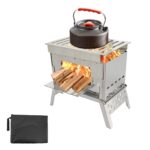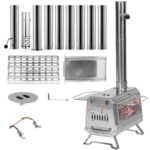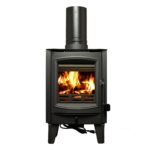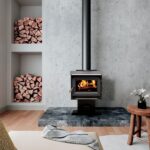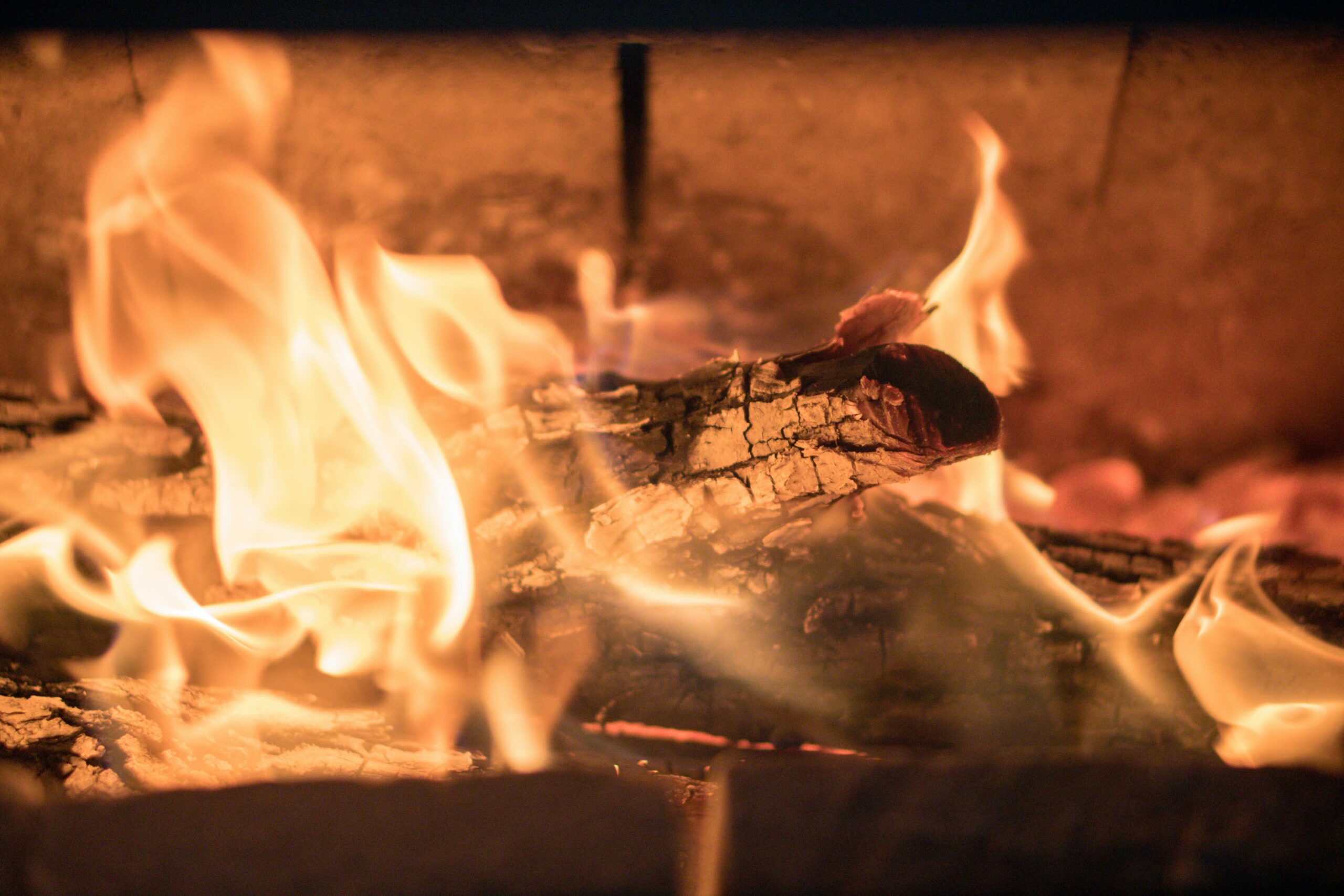
Introduction to Tent Wood-Burning Stoves
Tent wood-burning stoves have garnered significant attention among campers and outdoor enthusiasts, serving as valuable tools for enhancing the camping experience. These compact stoves, designed specifically for use in tents, provide not only warmth but also a means for cooking meals. The primary purpose of these stoves is to create a comfortable environment, enabling users to enjoy outdoor adventures regardless of weather conditions.
The popularity of tent wood-burning stoves can be attributed to their efficiency and adaptability. Unlike conventional camping heaters, which often rely on propane or other fuels, wood-burning stoves utilize natural resources readily available in the form of firewood. This reliance on wood not only promotes sustainability but also allows campers to connect more deeply with nature, utilizing the environment around them. As a result, these stoves have become an essential component of many outdoor trips, providing a reliable source of heat and comfort.
One of the most significant benefits of using a tent wood-burning stove is the warmth it generates. During colder months, the ability to heat a tent can make a considerable difference in overall comfort, ensuring a pleasant camping experience. Additionally, the stove’s cooking capabilities allow campers to prepare hot meals, enhancing their outdoor living experience. This is particularly advantageous in remote locations where access to cooking facilities may be limited.
Furthermore, as the outdoor industry continues to evolve, innovations in design and materials have led to the development of more efficient and lightweight options. This has made tent wood-burning stoves more accessible and appealing to a broader audience. With various models available, users can choose the one that best suits their individual needs and preferences, thus reinforcing the appeal of these versatile stoves in the outdoor recreation landscape.
Factors Influencing Firewood Consumption
The consumption of firewood in tent wood-burning stoves is determined by a variety of factors that can significantly influence efficiency and overall usage. A primary element affecting firewood consumption is the size of the stove itself. Smaller stoves require less firewood, while larger units may burn more in order to maintain desired temperatures. This variance highlights the importance of selecting an appropriately sized stove to match the specific heating needs of the tent and its occupants.
Stove efficiency is another critical factor. Modern wood-burning stoves are designed to burn wood more completely, resulting in lower firewood consumption compared to older, less efficient models. Stoves equipped with features such as secondary combustion systems can achieve higher temperatures and a cleaner burn, ultimately reducing the amount of firewood required. Thus, investing in a high-efficiency stove can lead to significant savings in firewood over time.
The type of wood used also plays a substantial role in firewood consumption. Different species of wood have varying densities and moisture contents, which affect how well they burn. Hardwoods like oak and hickory produce more heat and require less wood compared to softwoods such as pine, which may burn quicker but with less heat output. Furthermore, using seasoned or well-dried wood is crucial, as higher moisture content in freshly cut wood not only increases smoke and emissions but also leads to greater firewood consumption due to inefficient burning.
Environmental conditions, including outside temperature and humidity levels, cannot be overlooked as they impact how efficiently a wood-burning stove operates. Colder temperatures necessitate more intensive heating, which can result in increased firewood usage. Similarly, high humidity can affect how wood burns, causing it to smolder rather than produce efficient heat. By understanding these multifaceted factors, users can better manage their firewood consumption for tent wood-burning stoves, optimizing heating efficiency while minimizing waste.
Estimating Daily Firewood Needs
Estimating the daily firewood needs for a tent wood-burning stove is crucial for ensuring a steady supply of fuel and maintaining optimal performance. The consumption of firewood can significantly vary based on several factors, including usage patterns, outdoor environmental conditions, and the specific model of the wood-burning stove being used. Understanding these variables will help you create a reliable estimation method.
First, consider the stove’s efficiency and heat output. Different stove models have varying rates of firewood consumption, typically measured in pounds of wood burned per hour. To start estimating your daily needs, find the manufacturer’s specifications for your stove’s fuel consumption rate. For instance, a stove may burn approximately 2-4 pounds of wood per hour when operating at optimal temperature. If you plan to use your stove for an estimated 8 hours a day, this will create a potential daily need of 16-32 pounds of firewood.
Next, evaluate the outdoor conditions, as they can greatly affect firewood consumption. Colder temperatures often require more wood to maintain heat, while milder weather may reduce the amount needed. As a general guideline, for every ten-degree drop in temperature, you may increase your firewood consumption by approximately 10-20%. Additionally, wind exposure can increase heat loss, so consider adding extra wood to account for these external factors.
Lastly, keep track of your actual firewood usage over a few camping trips to refine your estimations. Gather data on how much firewood you have consumed, the outside temperatures, and the duration of stove use. This real-world information will help you adjust your calculations and provide a more accurate estimate for future outings. With these guidelines and awareness of your specific conditions, you will be well-prepared to estimate your firewood needs effectively.
Types of Wood and Their Burning Characteristics
Understanding the types of wood available for use in tent wood-burning stoves is essential for optimizing burning efficiency and heat output. Different wood species exhibit varying characteristics that influence their performance as firewood. Primarily, wood can be categorized into two main classes: hardwoods and softwoods. Each type has distinct properties that affect how efficiently they burn and the amount of heat they produce.
Hardwoods, such as oak, maple, and hickory, contain a higher density and lower moisture content compared to softwoods. This density translates to a slower burn rate, providing a longer-lasting fire. Hardwood species tend to produce more heat per unit of wood, making them an ideal choice for cooking and heating in wood-burning stoves. Moreover, because hardwoods burn more slowly, they often produce less smoke and ash, making for a cleaner-burning experience.
On the other hand, softwoods, which include pine, fir, and spruce, generally ignite more quickly and are easier to split. However, they tend to have a higher moisture content and lower density, resulting in a quicker burn time. While softwoods can provide immediate heat when starting a fire, they may require more frequent replenishment in a wood-burning stove. This can lead to increased firewood consumption over time.
The moisture content of wood is a critical aspect influencing burning characteristics. Freshly cut wood typically contains a high level of moisture, which requires longer drying periods to reach optimal burning conditions. Well-seasoned firewood, which has a moisture content of 20% or less, significantly improves efficiency, as less energy is wasted in evaporating moisture. Firewood consumption can be drastically reduced by selecting well-seasoned hardwoods or properly aged softwoods for burning.
Average Firewood Consumption Rates
The consumption rates of firewood in tent wood-burning stoves can vary significantly based on several factors, including stove efficiency, design, and usage patterns. However, experienced campers have provided useful benchmarks that can help gauge average daily firewood consumption. Typically, a tent wood-burning stove may consume between 5 to 10 pounds of firewood per day, depending on its size and the heat output required.
For instance, smaller, more compact stoves suitable for lightweight backpackers may utilize around 5 pounds of wood daily, particularly if used for short periods, such as boiling water or cooking meals. In contrast, larger or more robust stoves that provide ample warmth for extended durations can consume upwards of 10 pounds of firewood daily. It is important to monitor your stove’s performance and adjust firewood usage based on ambient temperatures and personal comfort levels.
Another consideration impacting firewood consumption is the stove’s operational practices. Tending the fire regularly and ensuring optimal air flow can improve efficiency, thus reducing the amount of firewood required. Practicing sound fire management techniques will extend the burning duration of your firewood, allowing for a more economical camping experience. By using these insights, campers can more accurately assess their needs and prepare effectively for their outdoor adventures.
Tips for Efficient Fuel Use
Maximizing the efficiency of firewood consumption in tent wood-burning stoves is essential for an enjoyable camping experience. The way you operate your stove and prepare your wood can significantly influence the amount of firewood required to maintain a consistent heat level. One crucial aspect of stove operation is to ensure proper airflow. Opening the air vents allows for improved combustion, thereby generating more heat with less wood. Conversely, limiting airflow can lead to inefficient burning and wasted fuel.
Additionally, utilizing optimal burning techniques can greatly enhance firewood efficiency. Starting your fire with small, dry kindling can help establish a strong flame sooner. Gradually adding larger, seasoned logs will ensure that the fire remains robust and sustainable. It is also advisable to adopt the ‘top-down’ burning method. In this technique, larger logs are placed at the bottom, followed by smaller pieces and kindling on top. This allows the fire to burn down through the wood, creating less smoke and maximizing heat output while minimizing the firewood needed for a comfortable environment.
Another critical factor to consider is the preparation of your firewood. Using well-seasoned, dry logs will ensure more efficient burning. Freshly cut wood retains moisture, leading to inefficient combustion and increased smoke emissions. Aim for wood that has been allowed to dry for at least six months. If possible, split the wood to increase its surface area; this will facilitate quicker drying and efficient burning. Properly storing your firewood, away from moisture and in a well-ventilated area, will ensure that it remains dry and ready for use. By incorporating these strategies into your camping routine, you will be able to optimize your wood-burning experience while minimizing the amount of firewood consumed.
Comparing Wood-Burning Stoves to Alternative Heating Solutions
When evaluating heating solutions for tents, wood-burning stoves present a unique option compared to propane heaters and electric heaters. Each heating solution comes with its own set of advantages and disadvantages which merit consideration based on individual needs and circumstances.
Wood-burning stoves offer a traditional heating method that utilizes readily available natural resources, such as wood. This can be particularly beneficial for campers and outdoor enthusiasts who value self-sufficiency and the experience of a real fire. They can potentially be less expensive in remote areas where wood is abundant. Additionally, wood-burning stoves can generate a significant amount of heat, creating a cozy atmosphere even in freezing temperatures. However, they do require manual effort to gather, store, and manage firewood, which may not appeal to everyone.
In contrast, propane heaters provide a more convenient heating solution, as they can heat a space quickly and with minimal setup. These units are generally portable and easier to control; however, they rely on fuel canisters, which may not be as readily available in wilderness settings. Additionally, propane heaters can present safety concerns, as they can produce carbon monoxide in enclosed spaces, necessitating proper ventilation. While the cost of propane can vary, the ongoing expense of purchasing gas can add up over time.
Electric heaters represent another alternative, particularly in locations with access to electricity. They are clean, producing no smoke or ash, which can lead to easier maintenance. However, they rely heavily on a power source, limiting their use in remote camping scenarios. The cost of electricity can also vary, which may impact the overall expense. Ultimately, when comparing wood-burning stoves with propane or electric heaters, it is essential to consider factors such as heat output, convenience, accessibility to fuel, and safety measures to determine the best option for your heating needs.
Safety Considerations with Tent Wood-Burning Stoves
Using a wood-burning stove in a tent can significantly enhance your camping experience by providing warmth and a cooking solution. However, it is imperative to follow strict safety guidelines to prevent accidents and ensure a safe environment. One of the foremost safety considerations is maintaining proper ventilation within the tent. A wood-burning stove consumes oxygen and produces carbon monoxide, a poisonous gas that can accumulate indoors. To mitigate this risk, ensure that your tent is equipped with adequate ventilation openings that allow fresh air to circulate and exhaust gases to escape. Additionally, consider using a carbon monoxide detector, which can provide an extra layer of safety by alerting you to dangerous levels of gas.
Fire safety practices are another critical aspect of using wood-burning stoves in tents. It is essential to position your stove on a stable, flat surface and to ensure it is at a safe distance from any flammable materials, including tent fabric, sleeping bags, and gear. Utilizing a heat shield can protect your tent and prevent potential ignition from the stove. Always keep a fire extinguisher or a bucket of water nearby in case of emergencies, and never leave the stove unattended while it is operational. Adhering to these fire safety measures is vital for an enjoyable camping trip.
Proper wood storage is equally important in ensuring a safe and efficient wood-burning stove operation. Store firewood away from the tent and at a safe distance from the stove to prevent accidental fires. It is advisable to keep only a small supply within reach during the night or while cooking, as this will reduce the likelihood of an uncontrolled fire. Following these guidelines will significantly lower the risk associated with using a wood-burning stove in a tent, making your camping experience more enjoyable and worry-free.
Conclusion and Final Thoughts
In considering the firewood consumption of tent wood-burning stoves, it is essential to recognize the various factors that play a significant role in determining how much wood will be required during your camping experience. Understanding the specifics, such as the stove’s efficiency, the type of wood used, and atmospheric conditions, can greatly influence the overall consumption of firewood. As discussed, different types of firewood provide varying levels of heat output, and using well-seasoned wood can enhance burning efficiency, thereby reducing the quantity needed for an effective fire.
Moreover, the size and design of the wood-burning stove itself can impact firewood consumption rates. Smaller stoves may require more frequent refueling, while larger models may boast greater sustainability when utilized correctly. The outdoor environment also plays a crucial role; windy conditions can lead to faster burning rates, necessitating additional firewood for warmth and cooking needs. Therefore, it is important to assess these variables before embarking on your camping trip.
Furthermore, careful planning and preparation are vital steps in managing your firewood supply. Calculating your firewood needs based on the length of your stay, the expected weather, and your intended activities can help to ensure that you do not run out of fuel during your adventure. By considering your unique camping circumstances, you can effectively adapt your strategies to effectively manage firewood consumption. Ultimately, being informed and mindful of these various factors will lead to a more enjoyable and stress-free camping experience with your tent wood-burning stove.


